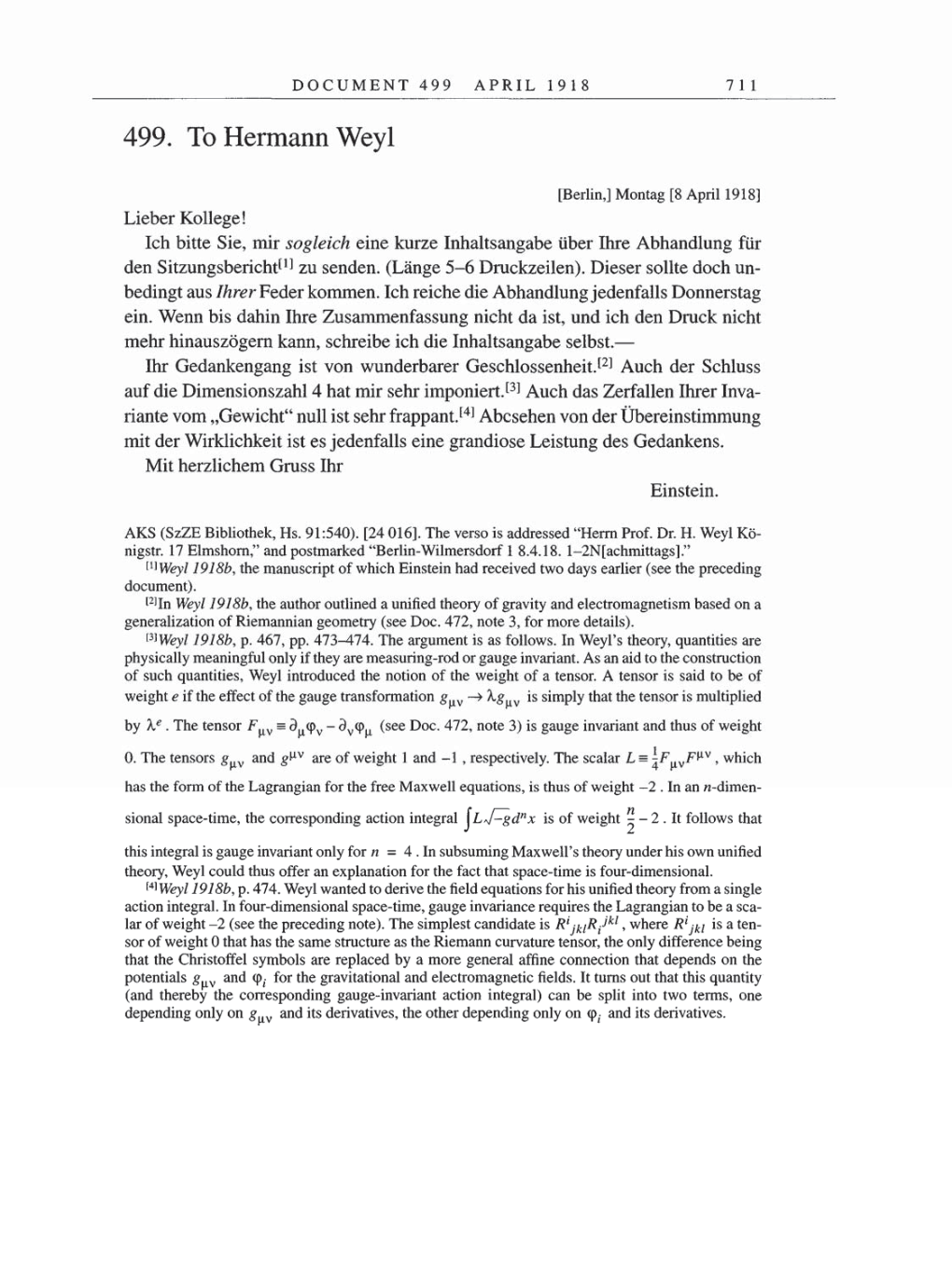DOCUMENT 499 APRIL 1918 711
499. To Hermann
Weyl
[Berlin,] Montag
[8
April 1918]
Lieber
Kollege!
Ich bitte
Sie,
mir
sogleich
eine kurze
Inhaltsangabe
über Ihre
Abhandlung
für
den
Sitzungsbericht[1]
zu
senden.
(Länge
5-6
Druckzeilen).
Dieser sollte doch
un-
bedingt
aus
Ihrer
Feder
kommen.
Ich reiche die
Abhandlung jedenfalls Donnerstag
ein.
Wenn bis
dahin Ihre
Zusammenfassung
nicht da
ist,
und
ich den Druck nicht
mehr
hinauszögern
kann,
schreibe ich die
Inhaltsangabe
selbst.-
Ihr
Gedankengang
ist
von
wunderbarer Geschlossenheit.[2] Auch der Schluss
auf
die Dimensionszahl 4 hat
mir
sehr
imponiert.[3]
Auch das Zerfallen Ihrer Inva-
riante
vom
"Gewicht" null ist sehr
frappant.[4]
Abcsehen
von
der
Übereinstimmung
mit der Wirklichkeit ist
es
jedenfalls
eine
grandiose
Leistung
des Gedankens.
Mit herzlichem Gruss Ihr
Einstein.
AKS
(SzZE Bibliothek,
Hs.
91:540). [24 016].
The
verso
is addressed "Herrn Prof. Dr. H.
Weyl
Kö-
nigstr.
17 Elmshorn,"
and
postmarked
"Berlin-Wilmersdorf
1
8.4.18.
1-2N[achmittags]."
[1]Weyl
1918b,
the
manuscript
of
which
Einstein
had
received two
days
earlier
(see
the
preceding
document).
[2]In
Weyl
1918b,
the author outlined
a
unified
theory
of
gravity
and
electromagnetism
based
on a
generalization
of
Riemannian
geometry
(see
Doc.
472,
note
3,
for
more
details).
[3]Weyl
1918b,
p.
467,
pp.
473-474.
The
argument
is
as
follows.
In
Weyl’s theory, quantities are
physically meaningful only
if
they are
measuring-rod
or gauge
invariant. As
an
aid
to
the
construction
of
such
quantities, Weyl
introduced the notion
of
the
weight
of
a
tensor.
A
tensor
is said to be of
weight e
if
the effect
of
the
gauge
transformation
guv
-
Xguv
is
simply
that the tensor
is
multiplied
by
Xe. The
tensor
Fuv
= duqv
-
dvqu
(see
Doc. 472,
note 3)
is
gauge
invariant and thus
of
weight
0. The
tensors
guv
and
guv are
of
weight
1
and
-1
,
respectively.
The scalar L
=
1/4FuvFuv,
which
has the form
of
the
Lagrangian
for the free Maxwell
equations,
is thus
of
weight
-2.
In
an
n-dimen-
sional
space-time,
the
corresponding
action
integral jL/-gdnx
is
of
weight
n/2
-
2.
It follows that
this
integral
is
gauge
invariant
only
for
n
=
4.
In
subsuming
Maxwell’s
theory
under his
own
unified
theory, Weyl
could thus offer
an explanation
for the fact that
space-time
is four-dimensional.
[4]Weyl
1918b,
p.
474.
Weyl
wanted
to
derive the field
equations
for his unified
theory
from
a single
action
integral.
In four-dimensional
space-time, gauge
invariance
requires
the
Lagrangian
to
be
a sca-
lar
of
weight
-2
(see
the
preceding note).
The
simplest
candidate is
RijklRijkl,
where Rijkl is
a
ten-
sor
of
weight
0 that has the
same
structure
as
the Riemann
curvature tensor,
the
only
difference
being
that the Christoffel
symbols are replaced by a more general
affine connection that
depends on
the
potentials
guv
and
pi
for the
gravitational
and
electromagnetic
fields.
It
turns out
that this
quantity
(and thereby
the
corresponding
gauge-invariant
action
integral) can
be
split
into
two
terms,
one
depending
only on
guv
and its derivatives,
the other
depending only on
qi
and its derivatives.
